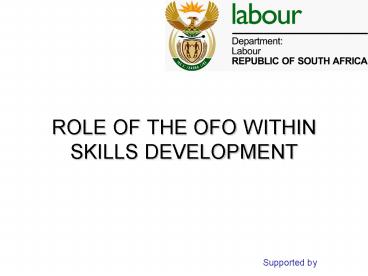ROLE OF THE OFO WITHIN SKILLS DEVELOPMENT - PowerPoint PPT Presentation
1 / 18
Title:
ROLE OF THE OFO WITHIN SKILLS DEVELOPMENT
Description:
Metal Fitters and Machinists. Mechanical Engineering ... METAL FITTERS AND MACHINISTS fit and assemble the fabricated metal ... 323202 Fitter and Turner ... – PowerPoint PPT presentation
Number of Views:162
Avg rating:3.0/5.0
Title: ROLE OF THE OFO WITHIN SKILLS DEVELOPMENT
1
ROLE OF THE OFO WITHIN SKILLS DEVELOPMENT
2
SDB ENABLES DEMAND DRIVEN OCCUPATIONAL LEARNING
SYSTEM
DoL
SETAs
NOPF
Report
Information
Reflect Industry Needs
QCTO
Economy
Flow of skills
Assessment Centres
Society
Provider System
Register Learning Programmes
Accredited Providers
Approved Workplaces
Learnerships Apprenticeships Skills Programmes
3
BACKGROUND - DEPARTMENT OF LABOUR RESPONSIBILITY
- During the latter part of 2003 the DoL realised
that OLS only meaningful if - labour market needs are accurately defined
- there is alignment between
- National Growth and Development Strategies and
- Skills Development Strategies required to support
it - a common language to speak about and define
occupations exist
4
DEVELOPING A COMMON LANGUAGE
- The starting point was the South African Standard
Classification of Occupations (SASCO), but SASCO
is outdated - only 625 distinct occupations
- insufficient detail on occupations
- In agreement with SETAs it was decided to work
with developments in Australia and New Zealand
(ANZSCO) - The end product became known as the Organising
Framework for Occupations (OFO - Based on ANZSCO)
5
WHAT IS THE OFO ?
- Skills based, coded classification system
- Captures all jobs but in the form of occupations
(Similar to SASCO) - Groups occupations in terms of -
- skill specialisation, and
- skill level
- into successively broader categories or
hierarchical levels (5) that can be used for
varying statistical and analysis purposes
6
UNDERSTANDING THE OFO CONCEPTS USED
- Occupation is set of jobs that require the
performance of similar or identical sets of tasks
across a range of contexts - Skill Specialisation (similarity of tasks) -
defined in terms of - Field of knowledge required
- Tools or equipment used
- Materials worked on or information worked with
- Goods or services provided
- Skill level - determined by
- Range and complexity of the tasks
- Level or amount of formal education and training
- Amount of previous experience in a related
occupation - Amount of on-the-job training
- required to competently perform the set of tasks
required for that occupation - There are 5 defined skill levels in the OFO
7
OFO STRUCTURE
Automotive and Engineering Technicians Trades
Workers
- Descriptor
- List of tasks / skills sets
Mechanical Engineering Trades Workers
Metal Fitters and Machinists
- Descriptor
8
DESCRIPTOR AND TASKS Unit Group level
9
OCCUPATIONAL DESCRIPTORS
10
OVERALL BENEFIT OF THE OFO
- Links industry needs to training interventions
and job oppertunities
11
BENEFITS OF THE OFO - DOL
- Provides a common language for collecting and
reporting on information related to occupations - Underpins Department of Labours ESSA System
- Compiling national scarce and critical skills
list - Registration of job seekers
- Registration of job vacancies
- Linking job-seekers to job opportunities
- Learnership registration
- Makes information more manageable (HSRC
validation of National Scarce skills list) - 3 year period and 3 national newspapers 125 000
advertisements for jobs - Unique job titles 28 000
- Mapped to OFO 1200 occupations
12
BENEFITS OF THE OFO - COMPANIES
- Not only to be used for compliance adds value
to processes - Can be used as tool to develop Workplace Skills
Plans - already used as basis for all Government
Departments WSPs through DPSA - Can link personal profiles to job profiles and
job profiles to occupational profiles - informs the development of individual development
plans - use for competency assessment
- Clarifies the concept of relevant experience in
job advertisements and limits irrelevant
application - Public Relations Officer 961 applications 73
CVs had the required qualification and experience
(7) - Economist 1116 applications 142 CVs had the
required qualification and experience (14)
13
(No Transcript)
14
BENEFITS OF THE OFO QCTO Occupational
Qualifications Framework (OQF)
- The 5 skill levels of the OFO provide
- an indicative link to the 10 NQF levels
- some guidance towards
- the formal education and training needs as well
as the - requisite amount and type of workplace experience
- to ensure a learner is able to practice
the occupation and - to be build into the occupational
qualification - Using the occupation as staring point would
eliminate duplication i.t.o qualifications - 1233 occupations and not all will have
occupational qualifications - Currently 6 apprenticeship schedules for plumbers
registered under 6 different SETAs, one SETA
developed qualification at level 3 and two FET
College qualifications, one each at levels 2 and
3.
15
BENEFITS OF THE OFO QCTO Curriculum Development
- The skill specialisation (i.e. the tasks or
skills sets) at unit group level of the hierarchy
provides - a link to the relevant SAQA learning fields
- greater guidance in terms of the required
- knowledge
- skills
- work experience activities
- for the general component of the curriculum and
- qualification
- guidance towards developing occupational tasks
for occupational profile
16
BENEFITS OF THE OFO QCTO Curriculum
Development (Cont)
- Clarify overlaps between qualifications and
simplify implementation - Ensure horizontal progression
Metal Fitters and Machinists
- Descriptor
- List of tasks / skills sets
- Descriptor
17
BENEFITS OF THE OFO QCTO Basis of NOPF
- The National Occupational Pathway Framework
(NOPF) will
- direct the scope of Communities of Expert
Practices (CEPs) to - ensure vertical progression
- clarify role players for CEP processes
18
Mining Engineers and Technologists
Mining Technicians
Drillers, Miners and Shot Firers
Mining support worker































